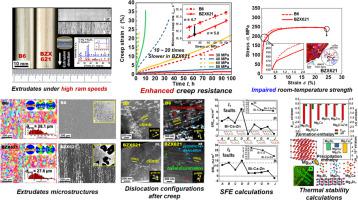当前位置:
X-MOL 学术
›
J. Mater. Sci. Technol.
›
论文详情
Our official English website, www.x-mol.net, welcomes your feedback! (Note: you will need to create a separate account there.)
Unexpected effects on creep resistance of an extruded Mg-Bi alloy by Zn and Ca co-addition: Experimental studies and first-principles calculations
Journal of Materials Science & Technology ( IF 10.9 ) Pub Date : 2024-03-19 , DOI: 10.1016/j.jmst.2024.01.083 Zhenyu Xiao , Shiwei Xu , Weiying Huang , Haifeng Liu , Xuyue Yang , Haikun Xu , Chao Ma , Chen Jin , Zhanhong Lin
Journal of Materials Science & Technology ( IF 10.9 ) Pub Date : 2024-03-19 , DOI: 10.1016/j.jmst.2024.01.083 Zhenyu Xiao , Shiwei Xu , Weiying Huang , Haifeng Liu , Xuyue Yang , Haikun Xu , Chao Ma , Chen Jin , Zhanhong Lin

|
In the present work, a new Mg-Bi based alloy is developed by the addition of Zn and Ca in equivalent atom fraction with Bi. Mg-Bi and Mg-Bi-Zn-Ca alloys were prepared by extrusion at a ram speed of 20 mm/s. Room temperature mechanical properties and creep behaviors at 423 K were investigated. The results show that Zn and Ca co-addition shows little influence on average grain size and texture intensity but changes the dispersive MgBi into MgBiCa particles in different sizes and a lower density. Twinning is largely activated during room-temperature deformation. Consequently, a slightly decreased proof strength but tripled elongation is shown at room temperature. Unexpectedly, large enhancement in creep resistance is detected after the co-alloying of Zn and Ca and the minimum creep rate is reduced by 10 to 20 times in the BZX621 alloy. Stress exponent = 4-5 indicates that the creep is a dislocation-climb controlled type. Post-mortem characterization on microstructure shows slip of dislocation <+> are also largely found in B6 as well as BZX621 alloy and cross-slip is detected more severe in B6 alloy. Dynamic segregation and precipitation are also seen in both alloys. Bi-clusters are seen dispersive across the grains in B6 and so did the PFZs that could undermine creep resistance at the grain boundaries. By contrast, Zn-rich needle-like precipitates are developed at most “ends” of <+> dislocations, which would hinder the further dislocation motions and thus improve the creep resistance. First-principles calculations were adopted and the results show that the thermal stability and thermomechanical properties of MgBiCa are much better than that of MgBi. Stacking faults energy is lowered down with the co-addition of Ca and Zn, which could inhibit the rate of dislocation climb and cross-slip. As a result, the improved creep resistance is obtained in the Mg-Bi-Zn-Ca alloys. Microstructural and controlling mechanism changes by thermal activation result in the unexpected enhancement in creep resistance with decreased room-temperature proof strength after co-addition. These findings could contribute to the development and optimization of creep-resistant Mg alloys in the future.
中文翻译:

Zn 和 Ca 共添加对挤压 Mg-Bi 合金的抗蠕变性能产生意想不到的影响:实验研究和第一性原理计算
在目前的工作中,通过添加与 Bi 原子分数相同的 Zn 和 Ca,开发了一种新型 Mg-Bi 基合金。 Mg-Bi 和 Mg-Bi-Zn-Ca 合金是通过挤压速度 20 mm/s 制备的。研究了室温机械性能和 423 K 下的蠕变行为。结果表明,Zn和Ca共添加对平均晶粒尺寸和织构强度影响不大,但将分散的MgBi转变为不同尺寸和较低密度的MgBiCa颗粒。孪生在室温变形过程中很大程度上被激活。因此,在室温下,屈服强度略有下降,但伸长率却增加了三倍。出乎意料的是,在BZX621合金中Zn和Ca共合金化后,抗蠕变能力得到了大幅提高,并且最小蠕变速率降低了10至20倍。应力指数 = 4-5 表明蠕变是位错爬升控制类型。微观结构的事后表征表明,B6 和 BZX621 合金中也大量发现了位错滑移,并且在 B6 合金中检测到交叉滑移更为严重。两种合金中也出现动态偏析和沉淀。 B6 中的双团簇分散在晶粒中,PFZ 也分散在晶粒边界上,从而破坏晶界的抗蠕变性。相比之下,在<+>位错的大部分“末端”发育富锌针状析出物,这会阻碍位错的进一步运动,从而提高抗蠕变能力。采用第一性原理计算,结果表明MgBiCa的热稳定性和热机械性能明显优于MgBi。 Ca和Zn的共同添加降低了堆垛层错能,抑制了位错攀爬和横滑移的速率。结果,Mg-Bi-Zn-Ca合金获得了改进的抗蠕变性。热活化引起的微观结构和控制机制的变化导致抗蠕变性意外增强,同时共添加后室温屈服强度降低。这些发现可能有助于未来抗蠕变镁合金的开发和优化。
更新日期:2024-03-19
中文翻译:

Zn 和 Ca 共添加对挤压 Mg-Bi 合金的抗蠕变性能产生意想不到的影响:实验研究和第一性原理计算
在目前的工作中,通过添加与 Bi 原子分数相同的 Zn 和 Ca,开发了一种新型 Mg-Bi 基合金。 Mg-Bi 和 Mg-Bi-Zn-Ca 合金是通过挤压速度 20 mm/s 制备的。研究了室温机械性能和 423 K 下的蠕变行为。结果表明,Zn和Ca共添加对平均晶粒尺寸和织构强度影响不大,但将分散的MgBi转变为不同尺寸和较低密度的MgBiCa颗粒。孪生在室温变形过程中很大程度上被激活。因此,在室温下,屈服强度略有下降,但伸长率却增加了三倍。出乎意料的是,在BZX621合金中Zn和Ca共合金化后,抗蠕变能力得到了大幅提高,并且最小蠕变速率降低了10至20倍。应力指数 = 4-5 表明蠕变是位错爬升控制类型。微观结构的事后表征表明,B6 和 BZX621 合金中也大量发现了位错滑移,并且在 B6 合金中检测到交叉滑移更为严重。两种合金中也出现动态偏析和沉淀。 B6 中的双团簇分散在晶粒中,PFZ 也分散在晶粒边界上,从而破坏晶界的抗蠕变性。相比之下,在<+>位错的大部分“末端”发育富锌针状析出物,这会阻碍位错的进一步运动,从而提高抗蠕变能力。采用第一性原理计算,结果表明MgBiCa的热稳定性和热机械性能明显优于MgBi。 Ca和Zn的共同添加降低了堆垛层错能,抑制了位错攀爬和横滑移的速率。结果,Mg-Bi-Zn-Ca合金获得了改进的抗蠕变性。热活化引起的微观结构和控制机制的变化导致抗蠕变性意外增强,同时共添加后室温屈服强度降低。这些发现可能有助于未来抗蠕变镁合金的开发和优化。



























 京公网安备 11010802027423号
京公网安备 11010802027423号